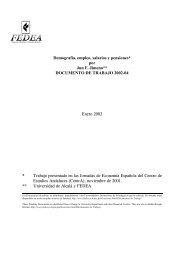The Evolution of Retirement by J. Ignacio Conde-Ruiz* Vincenzo ...
The Evolution of Retirement by J. Ignacio Conde-Ruiz* Vincenzo ...
The Evolution of Retirement by J. Ignacio Conde-Ruiz* Vincenzo ...
You also want an ePaper? Increase the reach of your titles
YUMPU automatically turns print PDFs into web optimized ePapers that Google loves.
In this paper, we aim at providing a long term perspective on the individual<br />
retirement behavior. We start from the role played at present <strong>by</strong> retirement<br />
decisions in social security and we analyze implications for the future <strong>of</strong> early<br />
retirement.<br />
First, we address the relation between the use <strong>of</strong> the early retirement provisions<br />
and the pension expenditure in a cross-country sample to evaluate the<br />
impact <strong>of</strong> the effective retirement age on the level <strong>of</strong> pension expenditure. We<br />
find that the total size <strong>of</strong> pension expenditure depends positively on different<br />
measures <strong>of</strong> early retirement, on the share <strong>of</strong> elderly in the population and on<br />
per capita GDP. To better investigate these relations, we decompose the total<br />
pension expenditure over GDP in the number <strong>of</strong> pensioners over total population<br />
and the average pension over per capita GDP. We find that early retirement<br />
shows a positive relation with the number <strong>of</strong> elderly, but hardly any relation<br />
with the average pension.<br />
Second, we provide a simple theoretical framework in which the incentives to<br />
retire early - as identified <strong>by</strong> Blondal and Scarpetta (1998) and Gruber and Wise<br />
(1999 and 2003) - are examined in conjunction with some long term determinants<br />
<strong>of</strong> the retirement decision.<br />
We use a Markovian politico-economic model to<br />
predict the equilibrium path <strong>of</strong> fiscal policies over social security. We find a<br />
political equilibrium characterized <strong>by</strong> an increasing sequence <strong>of</strong> social security<br />
tax rates converging to a steady state and <strong>by</strong> a parallel increment in the use<br />
<strong>of</strong> early retirement provisions. Comparative statics suggest that aging will lead<br />
to higher taxes and more early retirement. However, when income effects are<br />
factored in, the model suggests that period <strong>of</strong> stagnation — characterized <strong>by</strong><br />
decreasing labor income — may lead middle aged individuals to increase their<br />
labor supply and hence reduce early retirement.<br />
<strong>The</strong>re exists a vast literature on retirement decisions. Already two decades<br />
ago, Feldstein (1974) and Boskin (1977) analyzing the determinants <strong>of</strong> the de-<br />
3






